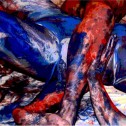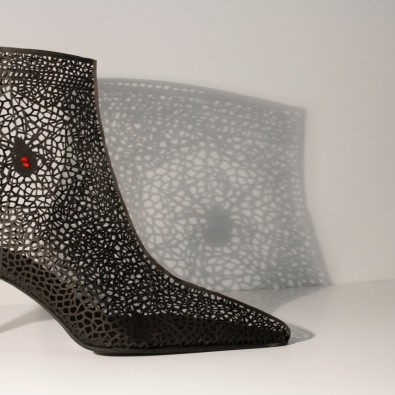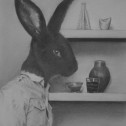Getting to the Bottom of what Art is about
Published as part of BBC’s Show Me The Monet coverage 11 May, 2011
This week, the UK’s BBC 2 TV channel has launched its new series Show Me The Monet, a genius title might I add, where a diverse mix of amateur and professional artists from all over the United Kingdom compete for a place at the London Royal College of Art show where they will display and sell their works to the highest bidder. To gain this privilege, artists must face the Hanging Committee, consisting of Chris Hollins, Charlotte Mullins and David Lee, three of the world’s toughest art critics. The criteria for success is based upon three factors: originality, technique and emotional power.
Over the coming weeks I will be interviewing some of the artists featured in the show to find out about their lives, inspirations and explore the messages they are trying to convey through their work.
First up, I am delighted to be talking to self-taught full-time artist and sculptress CJ Munn from Maidstone in Kent, who shocked the judges with her rather cheeky art-work, entitled ‘Wearing William’: it is a life-cast sculpture of her partner’s posterior. CJ’s hand-painted print design on this three-dimensional work was loosely inspired by William Morris, an English textile designer from the 1800s, also associated with the Pre-Raphaelite Brotherhood and the English Arts and Crafts Movement. CJ explained to the judges that she would like to see art returning to its old-fashioned aesthetic values as opposed to today’s “gimmickry, nonsense and shock-value”. She went on to say “This bottom belongs to my muse, who was also my mentor when I started life-casting, who became my friend, my colleague and now my boyfriend!” The judges ironically found the piece to be very much of shock-value but couldn’t help but like it for that very reason. Critic David Lee commented: “I am bewildered and that’s sufficient for me. Whenever I’m completely speechless about an object it usually means it’s got something.” During the final vote he said “Ridiculously, I’m going to say YES”. CJ made it through to the Royal College of Art’s Show Me The Monet exhibition which gained her the recognition she has been looking for.
There is something very unique and appealing to CJ’s work. Her techniques are certainly distinctive and the subject matter eye-catching. CJ explained “We [CJ and partner André] are like two genies stuck in a bottle waiting for someone to come and let us out, letting all this magic and creativity out.”
I talk to CJ to find out more….
CJ: I loved your pitch on the show. What was it like coming face to face with the Hanging Committee?
Thank you. Going in front of the Hanging Committee on Show Me the Monet has to be the single scariest moment of my entire career. Although individually the judges are quite personable, being grilled for half an hour by a bank of strangers over something you care passionately about is always going to be extraordinarily intimidating. Having the cameras there and the director interrupting on occasion with instructions intensified the pressure. When I walked in, my knees were actually shaking and my lips quivering like someone in a cartoon who has seen a ghost. I had to laugh at myself at the time and the surreal situation in order to pull it all together.
Ironically, the piece was described by the panel as having the ‘shock-value’, that you said you so wanted today’s art world to get away from. How do your works set themselves apart from contemporary pieces that deliberately set out to shock their audience?
Yes! I found that the most laughable thing that they all thought my work was shocking. A tasteful male nude is not shocking…you get them in nearly every fountain or museum in London. And a floral hand-painted pattern is not shocking. I was amused and surprised that they made the link between what I consider to be incredibly tame, sweet-natured work with that of the real shock jocks of the art world. What sets mine apart? Well, as I said in the show, my work represents, I hope, a return to an old fashioned aesthetic standard, where craftsmanship and real skill and beauty are valued above commercialism, gimmickry and controversy. I found it funny when Charlotte said she didn’t make an emotional connection to the piece. I wanted to say ‘It’s a pretty arse! What kind of emotional connection do you NEED to make with it?’. Why can’t art just be lovely, pleasant to look at, make people smile? Why does it always have to ‘mean something’? It didn’t used to have to. I think the art scene has got too caught up in itself to realise why people ever started making art, looking at it and collecting it in the first place. That’s not to say my work doesn’t mean anything, I have plenty of stories to tell in many of the pieces I’ve made – but if I truly wanted to shock or make a quick buck and win the Turner Prize I could easily make a giant crucifix from life-casts of the scrotums from a dead man’s corpse and have done with it! However, I would much rather make art that people will treasure, pass on to their descendants down family lines, make people smile when they look at it. Anyone can think up a gimmick. Not everyone can paint, sculpt, cast, weld, etc. There’s the difference…at least to me.
You told me that you and André work very much as a pair and may I say, you make a great team! How did you meet?
Ah thank you. We met about 8 and a half years ago on a life-casting forum. André used to work in the film industry before he became an artist, as a model-maker working on amazing feature films, pop videos and so forth. He was the most multi-talented man I’d ever met in my life and we instantly clicked due to all our shared interests and passions. It took a long time to work out we belonged together as a couple and we were just about everything else along the way – friends, colleagues, etc. Whenever we spoke or wrote about our work there would be this ‘spark’ like the other person just got what we meant without even needing to finish the sentence. We love working together, although still maintain quite independent creative lives for much of the time. It keeps things fresh to do our own solo projects as well as joint ones. We spark so many ideas off each other when we’re brainstorming that there isn’t enough time in two lifetimes to create all the things we want to make. But I feel so lucky to have found my partner in life and crime and to be able to share this passion for art with someone who cares about it and works as hard at it as I do.
I have to say, I do rather like the traditional flowered patterns with the golden edges you have so delicately hand-painted. Am I right in thinking that sculptures in a coloured or painted form are something of a rarity?
I never really thought about it until the judges in the Hanging Committee kept saying how original my piece was that this sort of thing was a rarity. I grew up in a household where nearly every square inch of every object was covered in some form of decoration, whether it was from family heirloom china passed down from Victorian ancestors or from my artist mother’s obsession with painting and stencilling. I don’t think it’s new, even if it’s rare now. The Victorians and Edwardians would hand-paint everything 3D from milk jugs to toilet bowls. But painted sculptures…surely even the Romans were doing that? I just think we’re used to seeing the sculptures with their colours faded away. Or maybe it’s a cultural thing…aboriginal art and African sculpture is often heavily decorated. If I have created something unusual then that’s wonderful. I wasn’t *trying* to, if you know what I mean. I just make things that I love to make, I love to look at, I love to touch and if other people love them and enjoy them too then that’s a bonus. I make my living from my commissions so obviously having the approval of at least a portion of the viewing public is important.
For me, the piece spoke of balance between old and new, using a traditional two-dimensional technique on a three-dimensional life-cast, but in doing so it breaks the norm of all traditions, still making it a contemporary piece with a cheeky twist. Tell me – Where do you place yourself in the evolution of art? What message you would like to convey to the world?
It sounds arrogant to suppose I will have any impact on the art world, but if I could make a wish it would be to ease the transition back to placing aesthetics and skill above nonsense, nepotism and PR games in the art world. I would love the many skilled and talented but poor artists I know to stand a chance of getting appreciated and paid a decent wage for their time, effort and skill. I would like to be the question mark that ends the sentence of shallow contemporary rubbish and starts a new paragraph in art appreciation. I know there are so many people out there that feel it’s time for a change, like I do. They don’t even have to like what I do, but they can support what I stand for. There is SO much talent out there going unrewarded and unseen. It’s time to give it a chance.
How long did “Wearing William” take to create in its entirety?
The casting/sculpting part of it took around 2 days I guess and the painting another 5-7 days if I remember correctly. Its female counterpart, ‘Mrs Morris’, took almost twice as long to paint as the pattern was so much more detailed. I do love seeing the patterns build up over the days. I don’t consider myself a painter, but I really enjoy the painting part – or engraving in the case of some of our other work. Every piece is different and some take many weeks, if not months. But this piece was quite simple and made purely for my own enjoyment.
I have to say it is visually exciting. Did you have fun creating it?
Oops, just answered that. I’m so glad you like it anyway. Yes, it’s an indulgent pleasure to spend so long on a piece that isn’t made to commission. I very much enjoyed it.
How long have you been sculpting?
Well, I won my first sculpture competition at the age of 10, designing a 3D monster for an opera version of ‘Where the Wild Things Are’ at the National Theatre, so does that count? It’s hard to put a date on it, but as my mother was an artist, I grew up making things, drawing, sculpting, carving, and generally designing things almost as soon as I could hold a penor tool. It came as second nature and was how we filled most of our time as children in our house. I’ve been life-casting for over 13 years now and a professional artist/caster/sculptor for nearly 9 years. I’m still learning though. You never stop learning.
Who are your inspirations?
My mother, the artist Diane Brazier (www.dianebrazier.co.uk), André of course, and then in the wider world I have to say I love the work of Ron Mueck – another ex-modelmaker from the film industry whose skill, humour and attention to detail never cease to amaze me. And then there’s Frida Kahlo – not the world’s best painter but one of my favourite artists through and through because she ate, slept and breathed it. She *was* her art. She was so passionate and determined and stubborn about it. She painted her body, her pain, her love, her longing. I relate to her so much as a woman and an artist. Plus she had a groovy monobrow. I’m aspiring to one of those one day.
I like your idea of cross-genre creations and the fact that you decorate your work with a range of mediums such painting, photography, mosaic-making, illustration and writing. Tell me more about combining these mediums.
I think it’s because I’m easily bored and even more easily inspired and don’t like to be tied down to one genre, style or medium. I paint, sculpt, write stories, poems, sing, cast, make jewellery – so why should anyone be made to choose just one pigeon hole when there is a whole world of fun stuff to try, to make, to taste and experiment with? So many things I want to do I just feel like I’m going to explode sometimes with the power and dizziness of it all. I know it’s far easier to market an artist who has one strong brand rather than half a dozen. And maybe that’s why I’m not rich yet, who knows, because I cannot and will not choose between genres. But I’m having so much fun…I’ve just got so much to do and say and make, so I’ll keep on doing what I do and if the work gets noticed and bought along the way then fantastic! But I will always be true to myself and my aesthetic principals.
What was it like exhibiting at the Royal College of Art to some of the world’s key art collectors?
It was a great honour, but to be honest the main honour was being in an exhibition with such a fantastic group of artists. There was so much talent and diversity in that one room. Not having gone to art college I missed out on connecting with a bunch of compadres, somaking friends through the show has been invaluable to me.
Do you have any exciting projects coming up?
André and I are designing some new pieces in a similar style to our copper and brass sculpture ‘Gaia’ as that is the one piece which seems to blow people’s socks off when they see it. It was an incredibly complex piece to make, but we’ve learned so much along the way, pioneering our own techniques with modern material technologies and traditional metalworking skills. And we’d like to put what we’ve learned to good use by creating smaller, more affordable pieces that collectors might want to snap up.
How can fans and art collectors contact you?
Our website is www.mastersandmunn.co.uk or if they want to see our workin the flesh we are currently showing several sculptures at The Fairfax Gallery, in Tunbridge Wells.
CJ – it’s been great speaking with you. Keep doing what you are doing, or shall I say: bottoms up?! (I know, I know, cringe-worthy comment, but I couldn’t resist….)
© The Culture Cave 2011. All rights reserved












